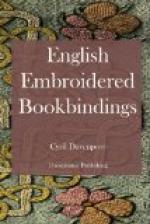[Illustration: 18—Queen Mary’s Psalter. 14th-century MS.]
Queen Mary’s Psalter. 14th-century MS. Bound about 1553.
The beautiful English manuscript of the fourteenth century known as ‘Queen Mary’s Psalter’ was presented to her in 1553. It is bound in crimson velvet, measuring 11 by 6-3/4 inches, and applique on each side is a large conventional pomegranate-flower worked on fine linen in coloured silks and gold thread. This flower is much worn, but enough is left to show that it was originally finely worked. Queen Mary used the pomegranate as a badge in memory of her mother, Katharine of Aragon. The volume has been re-backed in plain crimson velvet, and still retains the original gilt corners with bosses, and two clasps, on the plates of which are engraved the Tudor emblems,—portcullis, dragon, lion, and fleur-de-lys.
Christopherson, Historia Ecclesiastica. Lovanii, 1569.
Many fine bindings in embroidered velvet of the time of Queen Elizabeth still remain, several of them having been her own property.
One of the most decorative of these last is unfortunately in a very bad state, owing possibly to the fact that there were originally very many separate pearls upon it, and that these have from time to time been wilfully picked off. The book is in three volumes, and is a copy of the Historia Ecclesiastica, written by Christopherson, Bishop of Chichester, and printed at Louvain in 1569. Each of these volumes is bound in the same way, so the description of one of them will serve for all, except that no one volume is perfect, so the description must be taken as representing only what each originally was.
It is covered in deep green velvet, and measures 6 by 3-1/2 inches, the design being the same on each side. In the centre the royal coat-of-arms is applique in blue and red satin, on an ornamental cartouche of pink satin, with scrolls of gold threads and coloured silks, richly dotted with small pearls. The bearings on the coats-of-arms are solidly worked in fine gold threads.
From each corner of the sides springs a rose spray, with Tudor roses of red silk mixed with pearls, and Yorkist roses all worked in pearls clustering tight together, the leaves and stems being made in gold cord and guimp. A decoratively arranged ribbon outlined with gold cord and filled in with a line of small pearls set near each other, encloses the design, and numerous single pearls are set in the spaces between the roses and their leaves and stems.




